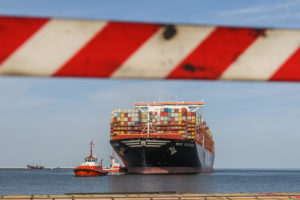The government of Nepal has a majority of nearly two-thirds in parliament, rare in the country’s 30-year-old multi-party democracy. It is also supposedly communist. The country’s new constitution, which came into effect in 2015, has clearly stated that the nation will move towards socialism. It is thus surprising that the new electricity bill tabled in the upper house of parliament refers to only one person by name: James D Wolfensohn, former president of the World Bank Group.
“More ridiculous is that Wolfensohn has been quoted as the former president of the United States of America. You can now guess how seriously it has been prepared,” chuckled Ratna Sansar Shrestha, a critic of hydropower policy in Nepal.
Lilamani Pokhrel, a leader in the ruling Nepal Communist Party, also finds this strange. “I have never seen a bill with a reference of a person as guiding framework. A sovereign country and the government putting a foreigner’s perspective as a framework for its law tabled for discussion in the parliament means there is something seriously wrong. Let alone [letting] go [of] socialism,” Pokhrel said during a recent webinar hosted by Nepal Water Conservation Foundation.
Called the Comprehensive Development Framework (CDF), the Wolfensohn framework is etched on the first page of the bill: “The market, the legislature, the judiciary, the media, political parties, business enterprises, nongovernmental organizations, and other economic, political, and social institutions all play specific, and interlinked, roles in the overall development experience of a country.”
All this is in the electricity bill because the Nepal government sees hydropower – and its export – as its major development goal and its path to socialism. The path, however, remains unlit and unclear.
A complicated legal history of hydropower in Nepal
Nepal’s first hydropower project was in 1911. More than eight decades after that, in 1992 the country promulgated its first electricity bill and came up with a hydropower development policy. Despite opposition from the communists, the then ruling Nepali Congress party allowed investments by private players in Nepal and abroad. “Communists were against it but we in Congress said that ultimately everybody is going to benefit so it’s good for the country and people. After rounds of hot debates, it was agreed by all. The new law opened doors for private investors in and out of country,” recalled Laxman Ghimire, former water resources minister.
In 2001, the government published a new hydropower development policy. Seven years after that, it tabled a bill in parliament to address the issues caused by the new policy.
The 2008 bill was opposed by activists, the private sector and some parliamentarians. An amendment with 142 points was filed in parliament. The government responded by withdrawing the bill altogether.
“A committee to deal with those issues was formed but no response was made because of the vested interests of several groups who didn’t wanted those to be addressed,” said Pokhrel, one of those in favour of the amendments.
Then Nepal started the tortuous process of writing a new constitution. Five years after the constitution came into effect, a fresh electricity bill was tabled in parliament this July.
See: Nepal’s eternal quest for hydropower – challenges and quakes
Many critics of the new bill
Under its new constitution, Nepal is now a federal country. The bill seeks to make licensing of hydro projects competitive rather than grant licences on a first-come-first-served basis. It also seeks to split the activities of the Nepal Electricity Authority (NEA), currently the sole agency for the production, transmission and distribution of power.
But, said, Ratna Sansar Shrestha, “It doesn’t anywhere say this electricity bill is needed because we need energy security. This should be clearly mentioned as the purpose of the new bill. And, it would be achieved by using water resources in the country. Nowhere in the bill has it considered multiple uses of water. Irrigation and drinking water are more important than electricity, as we have lived without electricity but can’t live without water and food.”
See: Nepal’s hydropower boom needs strategic assessment and public oversight
Experts are also wondering why the bill was tabled in the upper house. “This is a finance bill which is normally tabled in the lower house that has elected representatives. The upper house is more of a jamboree of nominated representatives. Why is this very important bill in the upper house? It needs a larger discussion in the lower house,” said Dipak Gyawali, former water resources minister and an expert on hydro policies.
There are more controversies. In 2017 a powerful electricity regulation commission was formed. It is mandated to regulate the generation, transmission, distribution and business of electricity. “The thing that is to be regulated is now on the table for discussion but the body that is supposed to regulate it is already formed. So what’s the purpose of this new bill? It should have been the other way around,” added Gyawali.
Nepal now generates nearly 1,400 megawatts of power, about half by the NEA and the rest by private companies. This is not enough to meet demand. Around 25% of the electricity consumed is imported from India, a figure that rose to nearly 35% in 2019. The demand is now down due to the lockdowns forced by the Covid-19 pandemic.
See: Covid-19 threatens to plunge Nepal’s power sector back into dark ages
Nepal has long wanted to sell electricity to India, but this vision has strong critics. Prakash Chandra Lohani, former finance minister, said, “The crux of this bill should have been how to use electricity in Nepal and flourish its own industries [sic]. But it lacks concentration around that. It repeats the same thing of selling to India and becoming rich. First, energy security in Nepal and then export to India should be the vision.”
See: Opinion: Who will buy Nepal’s hydropower?
The new bill proposes to control licensing systems and has a provision of power segregation on licensing for hydro projects. The three-tier government — local, provincial and federal — will be able to license up to three megawatts, up to 20 megawatts and above 20 megawatts respectively.
Shrestha said, “It’s OK to have this provision but any hydro project should be constructed for maximum power. However, with this clause the authorities may choose to reduce the potential power production and provide licences to developers. This would eventually reduce power (output) and more rivers will be dammed. It should be checked with some provision.”
More worryingly for Shrestha, the bill does not explicitly mention downstream benefits to India when large dams are built in Nepal. “I am not saying we should ask for benefits from water that is flowing naturally but if we build large reservoir projects upstream in Nepal by displacing thousands of people and submerging hectares of our land and that would benefit irrigation downstream then we should ask for compensation. This has not been strongly demanded in this bill.”
Not everyone agrees with this point of view. Some conservationists have demanded use of optimum rather than maximum capacity of hydropower as this would allow water use for other purposes. Currently it is mandatory to assure a minimum 10% flow in rivers that are dammed for hydro projects, but this is completely ignored by developers and authorities in practice.
Vishnu Pandey, a researcher at non-profit organisation International Water Management Institute (IWMI), said, “If we clearly mention in the act that optimum capacity would be generated then that would keep some space for other utilities including aquatic biodiversity.”
See: The importance of local voices in Nepal’s hydropower projects
Donor influence
The 2017 formation of the electricity regulation commission was considered one of the major goals of the USAID-funded Nepal hydropower development project. Some politicians in Kathmandu have alleged that the current bill was drafted under the influence of Millennium Challenge Compact (MCC), a highly controversial infrastructure project of the US government. The USD 500 million project has electricity infrastructure as one of its priorities. It was an issue that nearly split the Nepal Communist party, as many of its leaders claimed that the project had a military component.
The MCC is in trouble itself. Nepal’s Prime Minister KP Oli recently tried to get the MCC passed through parliament, but failed due to opposition within his own party.
Officials at the Ministry of Energy, Water Resources and Irrigation did not respond to questions on the new bill despite multiple attempts to contact them. This article will be updated if they respond.
![<p>Kali Gandaki “A” hydroelectricity project in Nepal [Image by: Asian Development Bank]</p>](https://dialogue.earth/content/uploads/2020/08/kali-gandaki-hydroelectricity-project--300x200.jpg)








![vehicles stranded due to a landslide atop a road being widened under the Char Dham Project [Image by Hemant Dhyani]](https://dialogue.earth/content/uploads/2020/08/CDP-Landslide-Hemant-Dhyani-300x201.jpg)